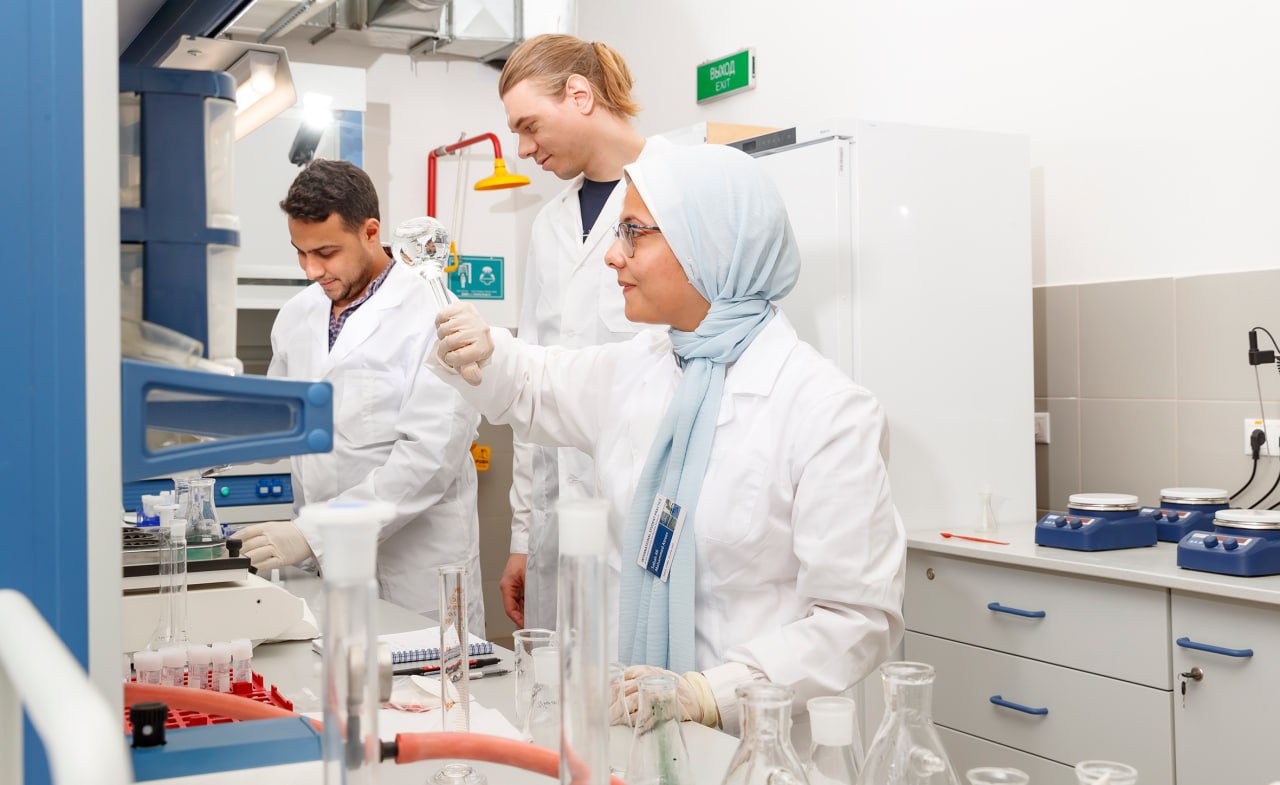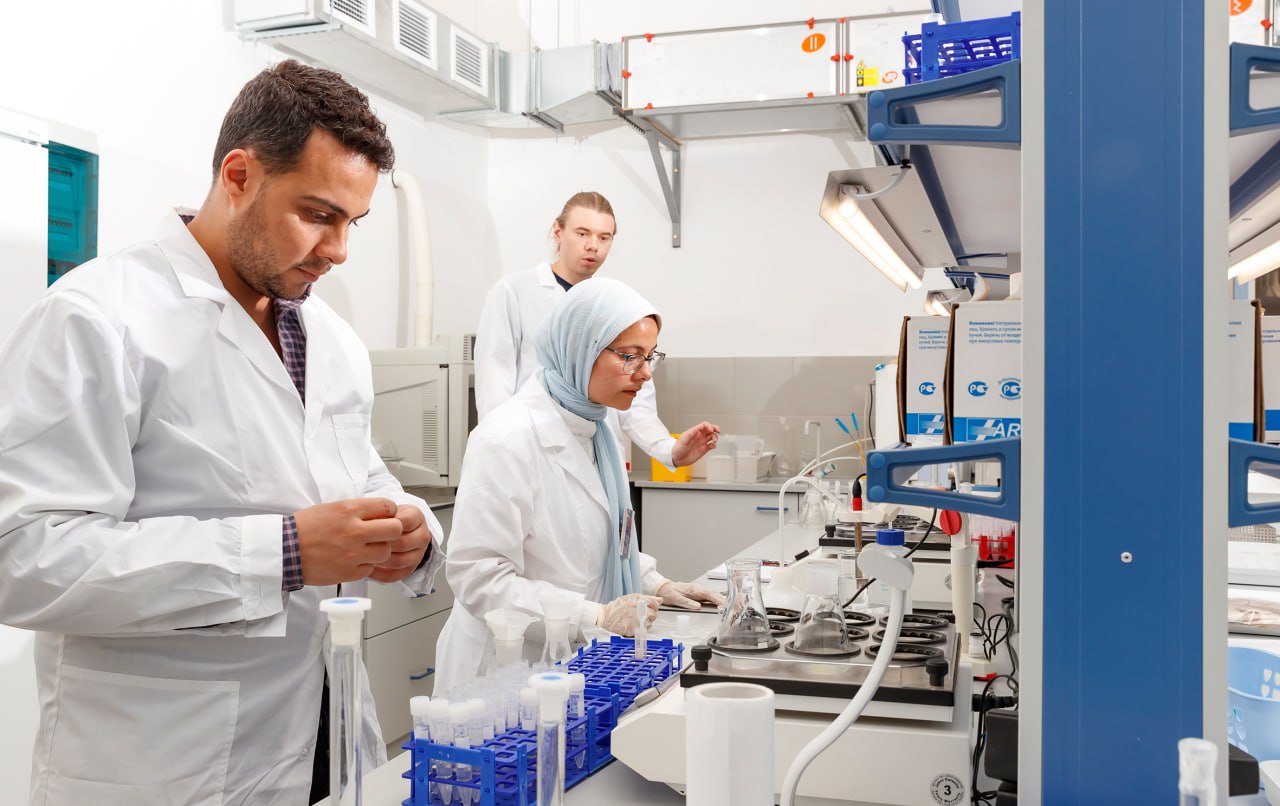Egyptian students removed rare-earth element from wastewater at internship in JINR
News, 13 October 2023
As part of the first stage of international practical training organized by the JINR University Centre, students from the British University in Egypt and Cairo University, together with researchers of the FLNP Sector of Neutron Activation Analysis and Applied Research, carried out a study on the removal of the rare earth element Tb (terbium) from wastewater using two types of sorbents: In2O3 (indium oxide) nanoparticles and biological sorbent Arthrospira platensis (spirulina). The results of these studies formed the basis of a scientific paper published in September this year in the journal Nanomaterials.
Terbium is now widely used in the production of components of smartphones, laptops, sensors, televisions and other electronic devices, and is also a key component of fluorescent lamps. Along with the growing demand for terbium from industrial companies, the amount of electronic waste containing this element has increased significantly. In addition, mining, unregulated waste disposal and lack of appropriate treatment processes contribute to rather high levels of rare earth elements in wastewater (from 1 to 200 mg/L). Therefore, scientists around the world today face an extremely important task of finding effective, environmentally friendly and cheap methods for removing terbium from waste and wastewater.
At present, bioadsorption is one of the most popular methods of metal removal, which is due to its simplicity, low cost and high adsorption capacity of biosorbents. What is more, materials produced from agricultural or biotechnological waste can be used as sorbents along with commercial adsorbents.
The question often arises as to which adsorbents (biological or specially synthesized) are more suitable for large-scale industrial applications. FLNP researchers together with students from Cairo tried to find an answer to this question.
“It all started as a usual training course, during which, it would seem, students should simply become familiar with our methods and gain theoretical knowledge. But the students turned out to be very interested and enthusiastic, and we went further,” says Inga Zinicovscaia, head of the FLNP Sector of Neutron Activation Analysis and Applied Research. – Islam Gomaa, a student from the British University in Egypt, brought with him indium oxide, which was synthesized by him and his colleagues from the University of Hail (Saudi Arabia), Port Said University, Suez Canal University (Egypt) and Cleveland State University (USA). Sabah Ali from Cairo University had some experience working with biological objects. We decided to carry out a study to compare Islam’s sorbent with the one we traditionally use—spirulina. During two weeks of fruitful work, we succeeded in conducting experiments and calculating experimental data so that the students could prepare a report on the results of their practical training. But then we decided to elaborate and finalize the report to a full-scale article. The paper was published in September this year in the journal Nanomaterials.”
 Islam Gomaa (British University, Cairo), Sabah Ali (Cairo University), Nikita Yushin (Sector of Neutron Activation Analysis and Applied Research, FLNP JINR)
Islam Gomaa (British University, Cairo), Sabah Ali (Cairo University), Nikita Yushin (Sector of Neutron Activation Analysis and Applied Research, FLNP JINR)
During the study, the researchers dissolved terbium salts in distilled water, and then mixed them with nanosorbent and spirulina biomass in different flasks. The effect of acidity (pH), terbium concentration and contact time on the sorption capacity of the tested materials was studied. As the results showed that at pH 2.0 for both adsorbents, the efficiency of removing terbium ions was low: 2.8% for indium oxide and 20.5% for spirulina biomass. The scientists explained the low adsorption by the competition of hydrogen ions with terbium ions for binding sites on the surface of adsorbents. An increase in pH contributed to an increase in the efficiency of removing terbium ions, which for indium oxide in the pH range of 4.0-7.0 was 98-99%. In the case of spirulina biomass, the maximum terbium removal of 66% was achieved at pH 3.0.
The effect of contact time on metal removal was studied to determine the equilibrium point at which maximum adsorption capacity is achieved and to explain the kinetics of the process. For both adsorbents, the removal efficiency increased sharply in the first 3 min of interaction of the sorbent with the sorbate, reaching 74% for indium oxide and 60% for spirulina biomass, then equilibrium was established in the systems.
With an increase in the initial concentration of terbium from 10 to 100 mg/l, the amount of adsorbed elements increased from 5.7 to 85.8 mg/g for spirulina biomass and from 9.4 to 60 mg/g for indium oxide. The increase in terbium adsorption with increasing concentration of its ions is explained by more frequent interactions between metal ions and adsorbents.
“Spirulina is a well-known cyanobacterium with excellent adaptability to high alkalinity, temperature, salt concentration and various pollutants,” emphasized Inga Zinicovscaia. – Other advantages of spirulina include ease of handling, high biomass productivity, and high metal biosorption capacity. Indium oxide, which is widely used as a semiconductor in photocatalytic degradation, solar cells and gas sensors, has also proven itself well as an adsorbent. From our point of view, both adsorbents are suitable for large-scale industrial applications. However, the advantage of spirulina is that it does not need to be synthesized in advance, like indium oxide, which means there is no need to spend resources on it.”
The conducted research has shown that the studied sorbents have a good potential for removing terbium ions from wastewater. The scientists also noted one more positive result of the study – the paper published in a well-known scientific journal marked the beginning of cooperation between FLNP researchers with a number of scientific institutes in Egypt, Saudi Arabia and the United States.
Link to an article:
- Al-Bagawi, A.H.; Yushin, N.; Hosny, N.M.; Gomaa, I.; Ali, S.; Boyd, W.C.; Kalil, H.; Zinicovscaia, I. Terbium Removal from Aqueous Solutions Using a In2O3 Nanoadsorbent and Arthrospira platensis Biomass. Nanomaterials 2023, 13, 2698. https://doi.org/10.3390/nano13192698
